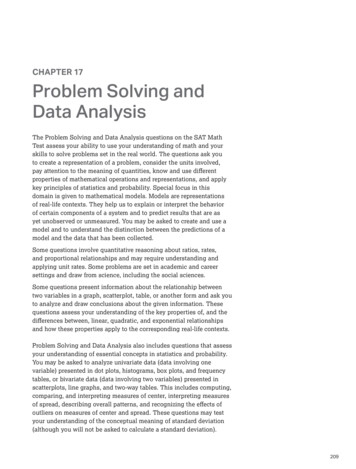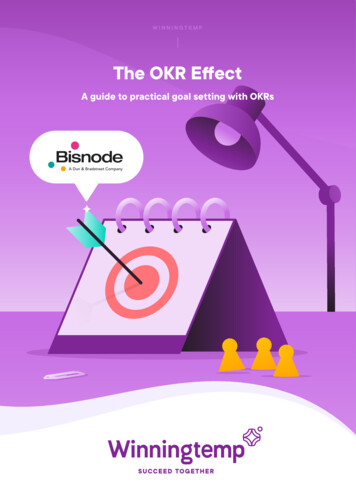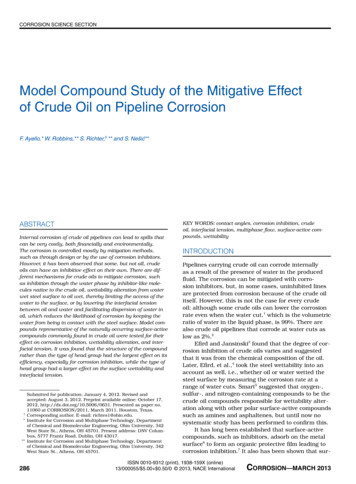
Transcription
Volume 4, Issue II, March 2015, ISSN:2277-1255BHARTIYAM INTERNATIONAL JOURNAL OF EDUCATION & RESEARCHA quarterly peer reviewed International Journal of Research & EducationEFFECT OF PROLEM SOLVING ABILITY ON ACADEMICACHIEVEMENT OF HIGH SCHOOL STUDENTS: ACOMPARATIVE STUDY*Madhu Gupta, **Pooja Pasrija & ***KavitaAbstractThe ability of problem solving has a fundamental role in students‟ academic performanceand their construction of the concepts. Keeping this in view, the present investigation hasbeen planned out to examine the effect of problem solving ability on the academicachievement of high school students. The descriptive method was adopted in the presentstudy. A sample of 250 students (165 male, 85 female) studying in 10th class of highschools affiliated to CBSE of Rohtak district was selected by using random samplingtechnique. In order to assess the Problem Solving Ability, Problem Solving Ability Test(PSAT) (2006) developed by Dr. L. N. Dubey was used. The marks obtained by thestudents in 9th class (previous class) were considered as the academic achievement ofstudents. ANOVA supplemented by t-test was applied for data analysis. The findings ofthe study revealed that problem solving ability had a significant effect on academicachievement of high school students. It is further revealed that the female studentsperformed better as compared to male students. However, no interaction effect of problemsolving ability and gender was found on academic achievement of high school students.Keywords: Problem Solving Ability, Academic Achievement, High School Students.INTRODUCTIONIn the highly achieving society of today, success has become an index of attaining positionand respect. Greater premium has been laid on the academic achievement of students. A goodacademic achievement record of students is an index of an effective educational system. It isthe tangible result of the quantity and quality of knowledge attained. It is the ripe fruit of slowand steady cultivation of knowledge and skills. Education is frequently concerned with theneed to improve students‟ academic achievement. The large number of researches on*Professor & Head, Department of Education, M.D.University, Rohtakmadhugupta1621@gmail.com** Assistant Professor, Vaish College of Education, Rohtakpoojapasrija@yahoo.com***Research Scholar, Department of Education, M.D.University, Rohtaksami19.kavi@gmail.com45
Volume 4, Issue II, March 2015, ISSN:2277-1255BHARTIYAM INTERNATIONAL JOURNAL OF EDUCATION & RESEARCHA quarterly peer reviewed International Journal of Research & Educationstudent‟s achievement bears testimony to this concern (Bajah, 1979 [4]; Babalola, 1979 [3];Holliday, 1981 [15]; Oni, 1981 [22]; Okoye, et al.2008 [24]).One of the major features of contemporary educational thinking is a growing concern aboutthe development of effective personality and efficiency of teaching learning outcomes thatcan be assessed in terms of students‟ achievement. Academic development of the pupil is theprimary concern and the most important goal of education. Academic achievement can bedefined as performance, knowledge or skill acquired after instructions and training in coursesor subjects of study, usually determined by test score or by marks assigned by teacher(Dictionary of Education, 2003)[8]. There are many factors which affect academicachievement viz. intelligence, personality, motivation, school environment, heredity, homeenvironment, learning, experiences at high school, interests, aptitudes, family background,socio economic status of the parents and many more other factors influenced the academicachievement. Despite this, one of the major factors of education is the ability of problemsolving that affect the academic achievement. Problem solving is the key to success and hasbeen regarded as the most significant aspect of human behaviour. Problem solving abilityplays an important role in the academic achievement of students and has been received broadpublic interest as an important competency in modern societies. In educational large-scaleassessments, paper-pencil based analytical problem solving was included first (Programmefor International Student Assessment, PISA, 2003(OECD, 2003 [23])). Enhancing students‟problem solving capacity is one of educational psychology‟s greatest challenges and is amajor demand placed on any educational institution (Mayer and Wittrock,2006 ) [18].Bearing this in mind, it is not surprising that educational large-scale assessments (LSAs)around the world have recently identified problem solving as a core domain thatcomplements classical literacy concepts in high school subjects.Problem solving is the framework or pattern within which creative thinking and reasoningtake place. According to Mayer and Wittrock (2006) [18], problem solving is cognitiveprocessing directed at achieving a goal when no solution method is obvious to the problemsolver. This definition consists of four parts: first part, problem solving is cognitive i.e.problem solving occurs within the problem solver's cognitive system and can only be inferredfrom the problem solver's behavior. The second part, problem solving is a process i.e.*Professor & Head, Department of Education, M.D.University, Rohtak** Assistant Professor, Vaish College of Education, Rohtak***Research Scholar, Department of Education, M.D.University, Rohtak46
Volume 4, Issue II, March 2015, ISSN:2277-1255BHARTIYAM INTERNATIONAL JOURNAL OF EDUCATION & RESEARCHA quarterly peer reviewed International Journal of Research & Educationproblem solving involves applying cognitive processes to cognitive representations in theproblem solver's cognitive system. The third part, problem solving is directed i.e. problemsolving is guided by the problem solver's goals and the last part, problem solving is personali.e. problem solving depends on the knowledge and skill of the problem solver. In sum,problem solving is cognitive processing directed at transforming a problem from the givenstate to the goal state when the problem solver is not immediately aware of a solutionmethod. Problem solving is related to other terms such as thinking, reasoning, decisionmaking, critical thinking, and creative thinking. Another important area is the study of humanproblem solving with subject matter areas such as reading, writing, Mathematics and Sciencethat is psychologies of subject matter (Mayer 1987). Instead of studying how people think ingeneral, psychologists of subject matter investigate how people think scientifically ormathematically or how people think within the process of reading or writing a passage. It wasalso revealed that problem solving is the best predictor of achievement of Mathematics andPhysics in high school students when gender was taken as demographic variable (Bhatt, 2014[5]; Kousar, 2010 [20]). Problem solving ability is necessary skill when students further intheir study. Many researches show that different abilities have been used in learning. Theresults show that sometime problem solving ability is successful with particular task ofstudents but sometime is not. Researchers have come out with varied results sometimescomplementary to each other, and sometimes contradicting each other .Thus, in the presentstudy attempt has been made in the direction of exploring the impact of problem solvingability on academic achievement.Theoretical Background / LiteratureLiterature points out that among the priorities, problem-solving ability is a requirement forsuccess in mathematics and science course (Dhir, 2014 [9]; Adesoji, 2008 [2]). Moreover,Darchingpui (1989) [7], Gupta (2014) [14] and Kumar et al. (2014) [17] pointed towards thestudents‟ Problem solving ability based on the variables types of the high school, academicsuccess, socio-economic and socio-cultural background. The ability of problem solving has afundamental role in students‟ academic performance and their construction of the concepts(Gakhar et al., 2004 [13]; Kousar, 2011[20]). Adesoji, 2008 [2] detected that there was no*Professor & Head, Department of Education, M.D.University, Rohtak** Assistant Professor, Vaish College of Education, Rohtak***Research Scholar, Department of Education, M.D.University, Rohtak47
Volume 4, Issue II, March 2015, ISSN:2277-1255BHARTIYAM INTERNATIONAL JOURNAL OF EDUCATION & RESEARCHA quarterly peer reviewed International Journal of Research & Educationdifference in the performance of students in the different ability levels after the treatment.The findings showed that students‟ ability have significant influence on problem-solving task(Adeyemo, 2010 [1]).However the effect of caste and gender was also found on problemsolving ability and academic achievement of students (Gupta, 2014 [14]). Improving theability of problem solving ability is a key factor for content learning. Most of the studiesgiven above carried out to assess the problem solving ability with science and mathematicsand different variables. However, no study has been carried out to assess the effectivenessproblem solving on academic achievement in relation to male and female. Under the light ofaforementioned information, the present study aims has been designed to access the effect ofgender and problem-solving ability of school students on academic achievement.OBJECTIVES OF THE STUDYThe present study asserts to meet the following objectives:1.To study the effect of problem solving ability on academic achievement of high schoolstudents.2.To study effect of gender on academic achievement of high school students.3.To study the interaction effect of problem solving ability and gender on academicachievement of high school students.DESIGN OF THE STUDYMethod: Descriptive survey method was used in this study.Sample The sample comprised 250 X class students from high schools affiliated to CBSEwas selected through random sampling technique. Further sample was bifurcated based onthe basis of gender i.e. male (165), female (85) and problem solving ability i.e. high problemsolving ability (75), average problem solving ability (75) and low problem solvingability(100) ).The breakup detail of sample is given in table 1.*Professor & Head, Department of Education, M.D.University, Rohtak** Assistant Professor, Vaish College of Education, Rohtak***Research Scholar, Department of Education, M.D.University, Rohtak48
Volume 4, Issue II, March 2015, ISSN:2277-1255BHARTIYAM INTERNATIONAL JOURNAL OF EDUCATION & RESEARCHA quarterly peer reviewed International Journal of Research & EducationTable 1: Breakup Details of the Sample Selected for the StudyProblem Solving AbilityGroupMaleFemaleHigh47(above15)28(above 14)AverageLow54( between 12-14)21(between11-13)Low64(below 11)36(below 10)GenderTool UsedProblem Solving Ability Test (PSAT) developed by Dr. L.N. Dubey (2006) [10] was used todetermine the level of problem solving ability among high school students. The reliabilitycalculated through split-half reliability coefficient was found to be 0.78 and the reliabilityalso calculated through rational equivalence method was found to be 0.76. The validity of thisscale was determined by finding correlation of scores with standardized test.Statistical Techniques EmployedMean and S.D. were worked out on the scores of achievement of high school students understudy. Analysis of Variance (ANOVA) with 3 2 factorial design was employed to study themain effects and interactional effect of independent variables (problem solving ability,gender) on dependent variable (academic achievement) supplemented by t-test. To test theassumption of homogeneity of variance for ANOVA, Levene‟s Test for homogeneity ofvariances was employed. The data was analyzed by using SPSS.DATA ANALYSIS & DISCUSSIONThis section explores the effect of problem solving ability and gender on academicachievement of the high school students. In the present study, the value of homogeneity ofvariance was calculated by Levene‟s test and it was 1.61 which is not significant at 0.05level of significance. It means that variance of all the six groups were similar.In order to study the main and interaction effects problem solving ability and gender onacademic achievement of the high school students, data was subjected to analysis of varianceof (3 2) factorial study with a randomized group design. In this section, the first independent*Professor & Head, Department of Education, M.D.University, Rohtak** Assistant Professor, Vaish College of Education, Rohtak***Research Scholar, Department of Education, M.D.University, Rohtak49
Volume 4, Issue II, March 2015, ISSN:2277-1255BHARTIYAM INTERNATIONAL JOURNAL OF EDUCATION & RESEARCHA quarterly peer reviewed International Journal of Research & Educationvariable i.e. problem solving ability coded as A was varied into three group high problemsolving ability (A1), average problem solving ability (A2) and low problem solving ability(A3). The second independent variable i.e. gender coded as B was varied at two levels male(B1) and female (B2). A layout of the factorial design used in the study for the variablesproblem solving ability and gender has been presented in Fig.1. The means and S.D.‟s ofdifferent sub-samples have also been presented in the Table 2. Mean achievement scores ofhigh school students in relation to problem solving ability and gender have been presentedgraphically in Fig.2ProblemSolvingAbility(A)High PSA(A1)Male(B1)Fig. 1:Low PSA( A3)Average PSA(A2)Female(B2)Male(B1)Female(B2)Male( B1)Female(B2)Schematic Layout of 3 2 Factorial Designs for Effect of Problem SolvingAbility and Gender on Academic Achievement of High School Students.Table 2: Means and S.D’s of Sub Samples for Achievement Scores of High SchoolStudent with respect to Problem Solving Ability and GenderPSAGenderNMeanS. D.High 10.57Low PSA(A3)Male (B1)Female(B2)643660.3071.789.9212.27*Professor & Head, Department of Education, M.D.University, Rohtak** Assistant Professor, Vaish College of Education, Rohtak***Research Scholar, Department of Education, M.D.University, Rohtak50
Volume 4, Issue II, March 2015, ISSN:2277-1255BHARTIYAM INTERNATIONAL JOURNAL OF EDUCATION & RESEARCHA quarterly peer reviewed International Journal of Research & gh PSAAverage PSALowPSAFig 2: Mean Achievement Scores of Sub Samples of High School Students withrespect to Problem Solving Ability(PSA) and GenderTable 3: Summary of Two-Way ANOVA for Mean Achievement Scores of High SchoolStudents with respect to Problem Solving Ability and GenderSources of *Gender 26(NS)Between cells510185.97 Within 6141.41Total24944688.933**Significant at 0.01 levelNS Not SignificantMain Effect (Problem Solving Ability (A) and Gender (B))Problem Solving Ability (A)For the main effect of problem solving ability on academic achievement of high schoolstudents, it is evident from Table 3 that F-ratio 12.54 with df 2 and 244 which is significant at0.01 level leading to the inference that problem solving ability has a significant role indetermining academic achievement. Therefore, it was found that there is significant effect ofproblem solving ability on academic achievement. It means that the students having the*Professor & Head, Department of Education, M.D.University, Rohtak** Assistant Professor, Vaish College of Education, Rohtak***Research Scholar, Department of Education, M.D.University, Rohtak51
Volume 4, Issue II, March 2015, ISSN:2277-1255BHARTIYAM INTERNATIONAL JOURNAL OF EDUCATION & RESEARCHA quarterly peer reviewed International Journal of Research & Educationproblem-solving approach showed much better academic achievement. The reason behindthat problem solving ability helps students to think and find the solutions more systematicallyand logically. The result is in agreement with the studies of Kousar Parveen (2010) [20] andChang et al. (2002) [6] who revealed that students showed good performance if they had theproblem solving ability. On the contrary, Jeotee (2012) [16] reported that the problem solvingability had negative influence on academic ability. In order to investigate further, to findwhich group among high PSA, average PSA and low PSA show better performance, one-wayANOVA is being computed and has been presented in Table 4.Table 4: Summary of One-Way ANOVA for Mean Achievement Scores of High schoolStudents with respect to Problem Solving AbilitySourcesDfSSMSAmong Groups59131.781826.38With in 3**** Significant at 0.01 levelThe F -ratio vide Table-4 for find the effect of high problem solving ability, low problemsolving ability and average problem solving ability on academic performance is 12.53 withdf 5 & 244 which is significant at 0.01 level leading to inference that there exists significantdifference in academic achievement of high school students of three groups of problemsolving ability. It means that high PSA, average PSA, low PSA groups show much differencein their academic achievement The„t‟ test has been further employed to find out thedifference in mean scores of academic achievement for different groups and has beenpresented in Table-4.1*Professor & Head, Department of Education, M.D.University, Rohtak** Assistant Professor, Vaish College of Education, Rohtak***Research Scholar, Department of Education, M.D.University, Rohtak52
Volume 4, Issue II, March 2015, ISSN:2277-1255BHARTIYAM INTERNATIONAL JOURNAL OF EDUCATION & RESEARCHA quarterly peer reviewed International Journal of Research & EducationTable 4.1:‘t’-values for the Mean Achievement Scores of High School Students withrespect to Problem Solving AbilityGroups of PSANMeanS.D.t-valueHPSA vs. APSA.757574.1068.7213.912.32.51*APSA vs. LPSA7510068.7264.412.312.262.31*LPSA vs. HPSA1007564.474.1012.2613.95.14**** Significant at 0.01 level*Significant at 0.05 levelHPSA High Problem Solving Ability; APSA Average Problem Solving Ability;LPSA Low Problem Solving Ability.It is clear from Table-4.1 that„t‟-value 2.51 with df 148 for the mean achievement scorebetween the high PSA and average PSA of high school students is significant at 0.05 level.The„t‟-value 2.31 with df 173 for the mean achievement score between the average PSA andlow PSA of high school students is significant at 0.05 level. The „t‟-value 5.14 with df 173for the mean achievement score between the high PSA And low PSA of high school studentsis significant at 0.01 level. In the context of mean scores, it has been found that the meanachievement scores of high school students of high PSA group (74.10) is more than ofgroups of average PSA (68.72) and low PSA (64.4) students. Therefore, it interpreted thathigh PSA have high academic achievement. The reason is that high problem solving abilityhelps in developing critical thinking in students, which helps in concept formation that is precondition for the good academic performance. This result is in agreement with the findings ofAdesoji (2008) [2] who reported that the students who are high achievers in problem solvingshowed superior academic achievement. The mean achievement scores for main effectcorresponding to problem solving ability on academic achievement have been presentedgraphically in Fig. 3.Gender (B)For the main effect of gender on academic achievement, it can be inferred from the Table 3that F-ratio is 40.38 with df 1, 244 which is significant at.0.01 level. It indicates that genderhas a significant role in determining academic achievement of high school students.Therefore, it was found that there exists significant effect of gender on academic achievement*Professor & Head, Department of Education, M.D.University, Rohtak** Assistant Professor, Vaish College of Education, Rohtak***Research Scholar, Department of Education, M.D.University, Rohtak53
Volume 4, Issue II, March 2015, ISSN:2277-1255BHARTIYAM INTERNATIONAL JOURNAL OF EDUCATION & RESEARCHA quarterly peer reviewed International Journal of Research & Educationof high school students. In order to investigate to support that result further the„t‟-value iscomputed and has been presented in Table-5.Table 5:‘t’-value for the Mean Achievement Scores of High School Students withrespect to 2.1‘t’- value6.68****Significant at 0.01 levelIt is evident from the Table 5 that„t‟-value is 6.68 with df 248 for the mean scores ofacademic achievement between the male students and female students is significant at 0.01level. In the context of mean scores, it has been found that the mean score of academicachievement of female students (75.53) is higher than male students (65.05). The girls areperforming better than boys. The reason may be that female students treated equally in theirdevelopment and education and provided the congenial environment. This result is inagreement with the findings of Nataraj and Manjula (2012) [21] & Farooq et al. (2011) [12]who reported that female students showed higher academic achievement as compared to themale students of high school. This result is in contrast with findings of Kumar et al. (2014)[17] and Kalhotra (2010) [19] who reported that male students showed high achievement thanfemale. The mean scores for the effect of gender on academic achievement have beenpresented graphically in Fig. 3.Interaction Effect of Problem Solving Ability and Gender on Mean Achievement Scoresof High School Students (A B)From Table 3, the value of F-ration for interaction of problem solving ability and gender is0.26 with df 2, 244. Which is not significant interaction effect between problem solvingability and gender at 0.01 level .It leads to the inference that problem solving ability andgender do not interact with each other. Therefore, it is found that there exists no significantinteraction effect of problem solving ability and gender on academic achievement of highschool students. This finding is in agreement with findings of Sirohi & Usha (2013)[25] whorevealed that male and female of under graduate students do not differ as regards to theirproblem solving ability. Therefore, it may be said that the problem solving ability of bothgroups male and female is same with regard to their academic achievement of high school*Professor & Head, Department of Education, M.D.University, Rohtak** Assistant Professor, Vaish College of Education, Rohtak***Research Scholar, Department of Education, M.D.University, Rohtak54
Volume 4, Issue II, March 2015, ISSN:2277-1255BHARTIYAM INTERNATIONAL JOURNAL OF EDUCATION & RESEARCHA quarterly peer reviewed International Journal of Research & Educationstudents. The reason for this finding is that both groups provided same education so that haveapproximate same cognitive abilities. This result is in contrast with findings of Nataraj andManjula (2012)[21]; Kumar et al.(2014)[17] and Kalhotra (2010)[19] who reported problemsolving ability of both groups male and female were different with regard to their academicachievement. The Line graph in Fig.4 shows that there is no interaction effect of PSA andgender on academic achievement of high school students.75.8474.168.7265.5664.4MaleFemaleHigh PSAveragePSLow PSFig.3: Mean Achievement Scores for Main Effects of Problem Solving Abilityand Gender on Academic Achievement of High School StudentsFig 3: The interaction effect of Problem Solving Ability and Genderon Achievement scores of High School Students*Professor & Head, Department of Education, M.D.University, Rohtak** Assistant Professor, Vaish College of Education, Rohtak***Research Scholar, Department of Education, M.D.University, Rohtak55
Volume 4, Issue II, March 2015, ISSN:2277-1255BHARTIYAM INTERNATIONAL JOURNAL OF EDUCATION & RESEARCHA quarterly peer reviewed International Journal of Research & EducationFINDINGS OF THE STUDY The study revealed that problem solving ability had a significant effect on meanachievement scores of high school students. A significant difference found in academicachievement among high, average and low problem solving ability high school students.It further revealed that students with high problem solving ability also exhibited highacademic achievement than average problem solving ability students and low problemsolving ability. Gender was reported to have a significant effect in mean achievement scores of highschool students. After comparing the mean achievement scores of boys and girls withthe help of t-test, significant difference was found between the achievement scores ofboys and girls leading to the conclusion that female students performed higheracademic achievement as compare to male students of high schools. No significant interaction effect of problem solving ability and gender on meanachievement scores of high school students was found.EDUCATIONAL IMPLICATIONSIn the present study, it was found that there is very much influence of problem solving abilityon the academic achievement of students. Problem solving is an individualized process,which requires various strategies to tackle. The classroom teacher can develop a scientificapproach to solve problems that the students are expected to face in social life. Theimplication of this study is that all pupils can be provided with an environment, which issuitable according to their behaviour so that their creativity may be flourished. Moreover,home & school can play important roles in developing a positive attitude for the developmentof creativity among students. Teacher can use pedagogical strategy for foster problem solvingability. The low level of problem solving ability is a pointer towards “learning deficiencysyndrome” and needs attention of school authorities. Therefore, school authorities need totake steps to diagnose the crucial difficulty areas in basic education. For this purpose, thehigh school teachers are required to be trained for use of diagnostic and criterion basedevaluation procedures to make teaching-learning process more effective as well as childcentered to enhance level of problem solving ability.*Professor & Head, Department of Education, M.D.University, Rohtak** Assistant Professor, Vaish College of Education, Rohtak***Research Scholar, Department of Education, M.D.University, Rohtak56
Volume 4, Issue II, March 2015, ISSN:2277-1255BHARTIYAM INTERNATIONAL JOURNAL OF EDUCATION & RESEARCHA quarterly peer reviewed International Journal of Research & EducationTeaching methodology and technique may need to be revised to increase the problem solvingability. It is the responsibility of the teachers to identify such students who have low problemsolving abilities and try to modify their learning and thinking power through various audiovisual aids. Teachers must encourage students to adopt a reasonable risk-taking attitude whilesolving problems. Risk-taking attitude leads the students to overcome mental fixation whilesolving problems in skill tests, such as, reasoning skills test, problem solving ability test,personality test, and so on. The findings of the study also exhibited that demographic variablesuch as gender has significant effect on the academic achievement of high school students.The female students possess significantly higher academic achievement than their malecounterparts did. Studies such as this one can assist with the understanding of student‟sproblem solving ability from an empirical point of view. In brief, it has been concluded thatproblem solving ability of the students help them building strong cognitive ability, whichshould be in a better position to reap the benefits of high academic achievement, enrolled inreliable future career choice and job availability.REFERENCES[1] Adeyemo, S. A. (2010). Students‟ ability level and their competence in problemsolving task in physics. International Journal of Education Research and Technology(IJERT), 1 (2), 35-47.[2] Adesoji, F. A. (2008). Students‟ ability levels and effectiveness of problem solvinginstructional strategy. Journal of Social Sciences, 17 (1), 5-8.[3] Babalola, B.A. (1979). The relationship between field dependent and fieldindependent cognitive styles and academic achievement in mathematics and sciencesubjects among Nigerian school students. Journal of Science Teachers Association ofNigeria, 15(1), 20-24.[4]Bajah, S.T. (1979), Correlates of students extrinsic High school Environmentalfactors with level of attainment in a standardized test in chemistry. Journal of ScienceTeachers Association of Nigeria, 18 (2).[5] Bhatt, M. A. (2014). Effect of problem solving ability on the achievement inmathematics of high school students. Indian Journal of Applied Research. Vol. 4(8),285-288. ISSN - 2249-555X,[6] Chang, C. and Weng, Y. (2002). An exploratory study on students' problem-solvingability in earth science. International Journal of Science Education, 24 (5), 441- 451*Professor & Head, Department of Education, M.D.University, Rohtak** Assistant Professor, Vaish College of Education, Rohtak***Research Scholar, Department of Education, M.D.University, Rohtak57
Volume 4, Issue II, March 2015, ISSN:2277-1255BHARTIYAM INTERNATIONAL JOURNAL OF EDUCATION & RESEARCHA quarterly peer reviewed International Journal of Research & Education[7] Darchingpui, A. (1989). A study of science achievement, science attitude andproblem solving ability among school students in Aizawl. Fifth Survey ofEducational Research, 2, N.C .E.R.T., New Delhi.[8] Dictionary of Education (2003). Retrieved from[9]www.dictionaryof education.comDhir T. (2014). Problem solving ability and science process skills as the influentialfactors of scientific creativity. International Journal of Research Pedagogy&Technology in Education & Movement science (IJEMS). 2 (4), 11-17.[10] Dubey, L. N. (1971). Manuals for Problem Solving Ability (PSAT). Ag
problem solving occurs within the problem solver's cognitive system and can only be inferred from the problem solver's behavior. The second part, problem solving is a process i.e. . Statistical Techniques Employed Mean and S.D. were worked out on the scores of achievement of high school students under study. Analysis of Variance (ANOVA) with .










